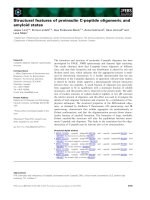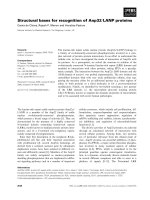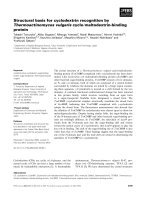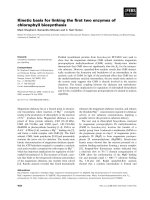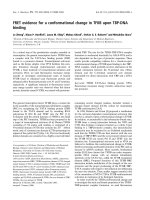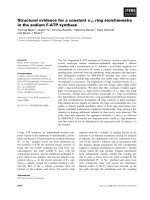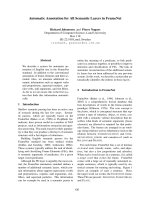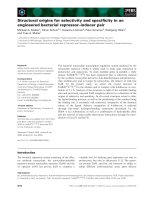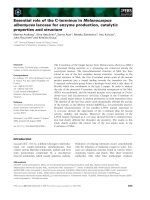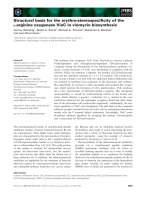Báo cáo khoa học: Structural basis for stereo-specific catalysis in NAD+-dependent (R )-2-hydroxyglutarate dehydrogenase from Acidaminococcus fermentans pptx
Bạn đang xem bản rút gọn của tài liệu. Xem và tải ngay bản đầy đủ của tài liệu tại đây (1.03 MB, 13 trang )
Structural basis for stereo-specific catalysis in
NAD
+
-dependent (R )-2-hydroxyglutarate dehydrogenase
from Acidaminococcus fermentans
Berta M. Martins
1,
*, Sandra Macedo-Ribeiro
2
, Julia Bresser
3
, Wolfgang Buckel
3
and
Albrecht Messerschmidt
1
1 MPI Biochemie, Strukturforschung, Martinsried, Germany
2 Centro de Neurocie
ˆ
ncias e Biologia Celular, Coimbra, Portugal
3 Laboratorium Mikrobiologie, FB Biologie, Philipps-Universita
¨
t, Marburg, Germany
The physiological role of NAD
+
-dependent (R)-2-
hydroxyglutarate dehydrogenase (HGDH, E.C. 1.1.1 )
is the reduction of 2-oxoglutarate (pK
eq
¼ 11.8) to
(R)-2-hydroxyglutarate coupled with the oxidation of
NADH to NAD
+
(Scheme 1). The reaction equilibrium
constant (K
eq
¼ 1.47 · 10
)12
M
) lies on the side of
(R)-2-hydroxyglutarate production [1]. The optimum
pH is 8.0 (specific activity of 4800 UÆmg
)1
) with a K
m
value of 134 l
M
for 2-oxoglutarate (at 100 l
M
NADH)
[2]. In Acidaminococcus fermentans, a nonpathogenic
Gram-negative bacterium (order Clostridiales, family
Acidaminococcaceae) commonly found in the digestive
tract of mammals [3], HGDH catalyses the second
step of the hydroxyglutarate pathway in glutamate fer-
mentation, the prominent energy metabolism in the
microorganism [4]. During catalysis, the 4Re-hydrogen
Keywords
D
-2-hydroxyacid dehydrogenase; NAD
+
-
dependent hydride transfer; (R)-2-
hydroxyglutarate; substrate recognition ⁄
stereospecificity; phase combination
Correspondence
B. M. Martins or A. Messerschmidt, MPI
Biochemie, Strukturforschung, 82152
Martinsried, Germany
Fax: +49 89 85783516
Tel: +49 89 85782669
E-mails: ;
Website: />*Present address
Laboratorium Proteinkristallographie, Univer-
sita
¨
t Bayreuth, 95440 Bayreuth, Germany
(Received 27 July 2004, revised 29 September
2004, accepted 29 September 2004)
doi:10.1111/j.1432-1033.2004.04417.x
NAD
+
-dependent (R)-2-hydroxyglutarate dehydrogenase (HGDH) cata-
lyses the reduction of 2-oxoglutarate to (R )-2-hydroxyglutarate and belongs
to the
D
-2-hydroxyacid NAD
+
-dependent dehydrogenase (
D
-2-hydroxyacid
dehydrogenase) protein family. Its crystal structure was determined by
phase combination to 1.98 A
˚
resolution. Structure–function relationships
obtained by the comparison of HGDH with other members of the
D
-2-
hydroxyacid dehydrogenase family give a chemically satisfying view of the
substrate stereoselectivity and catalytic requirements for the hydride trans-
fer reaction. A model for substrate recognition and turnover is discussed.
The HGDH active site architecture is structurally optimized to recognize
and bind the negatively charged substrate 2-oxoglutarate. The structural
position of the side chain of Arg52, and its counterparts in other family
members, strongly correlates with substrate specificity towards substitutions
at the C3 atom (linear or branched substrates). Arg235 interacts with the
substrate’s a-carboxylate and carbonyl groups, having a dual role in both
substrate binding and activation, and the c-carboxylate group can dock at
an arginine cluster. The proton-relay system built up by Glu264 and
His297 permits His297 to act as acid–base catalyst and the 4Re-hydrogen
from NADH is transferred as hydride to the carbonyl group Si-face lead-
ing to the formation of the correct enantiomer (R)-2-hydroxyglutarate.
Abbreviations
HGDH, NAD
+
-dependent (R)-2-hydroxyglutarate dehydrogenase; FDH, NAD
+
-dependent formate dehydrogenase; GDH, NAD
+
-dependent
D
-glycerate dehydrogenase; PGDH, NAD
+
-dependent
D
-3-phosphoglycerate dehydrogenase; LDH, NAD
+
-dependent
D
-lactate dehydrogenase;
HicDH, NAD
+
-dependent
D
-2-hydroxyisocaproate dehydrogenase.
FEBS Journal 272 (2005) 269–281 ª 2004 FEBS 269
(Prelog–Helmchen Re ⁄ Si-system [5]), at the C4N atom
of the nicotinamide moiety of the reduced coenzyme
(NADH), is transferred as hydride [6], making HGDH
an ‘A-side’ specific dehydrogenase [7,8].
HGDH is a member of the
D
-2-hydroxyacid dehy-
drogenase protein family [9]. Other members structur-
ally characterized are formate dehydrogenase ([10,11],
Protein Data Bank (PDB) codes 2NAC and 2NAD for
apo- and holoFDH, respectively),
D
-glycerate dehydro-
genase ([12], PDB code 1GDH for apoGDH),
D
-3-phos-
phoglycerate dehydrogenase ([13], PDB code 1PSD for
holoPGDH),
D
-lactate dehydrogenase (PDB code
2DLD for the ternary complex of LDH with oxamate;
[14]; PDB code 1J49 for h oloLDH [15]) and
D
-2-hydroxy-
isocaproate dehydrogenase ([16], PDB code 1DXY for
the ternary complex of HicDH with 2-oxoisocaproate).
This protein family has considerable biotechnological
potential in the chiral synthesis of both organic com-
pounds and nonproteogenic amino acids for pharma-
ceutical and medical applications (e.g. used as a
diagnostic reagent to monitor the serum levels of amino
acids that accumulate in a range of metabolic diseases)
[17,18].
D
-2-Hydroxyacid dehydrogenases are structurally
folded into two domains joined by a hinge and separ-
ated by a deep cleft containing the active site. The
hinge region mediates domain movements involved in
enzymatic catalysis (examples for such an enzymatic
reaction are given in [19] and references within).
Whereas the smaller domain referred to as the catalytic
or substrate-binding domain can be quite variable in
structure (as expected from the diverse substrate specif-
icity), the larger domain designated the nucleotide-
binding domain displays a well-preserved fold
indicating its evolutionary structural conservation (as
expected from its role in coenzyme binding). The same
protein overall fold (structural variant of the bab
Rossmann fold [20]), is displayed by members of the
transcriptional regulators protein family (C-terminal
binding protein, CtBP [21]).
The key catalytic residues have been identified by
biochemical [22–27] and structural analyses ([11–
13,15]). A conserved histidine-glutamate pair functions
as a proton-relay system. An arginine lining the active
site has been implicated in recognition and binding of
the substrate by a salt bridge with the carboxyl group.
The coenzyme binding mode, in a ‘boomerang’ confor-
mation with the carboxamide of the nicotinamide moi-
ety anti to the ribose moiety has been characterized in
the crystal structures of holoFDH [11], holoPGDH
[13], the ternary complex of HicDH [16] and the holo-
and ternary complex of LDH ([15], PDB code 2DLD).
This orientation directs the Re-hydrogen (pro-R hydro-
gen) of the nicotinamide ring towards the substrate to
be reduced. This explains the pro-R (A-side) specificity
displayed by these enzymes [28]. However, it remains
to be clarified how the protein backbone controls the
substrate stereorecognition for each member of the
protein family as their substrates range from the small
formate (nonchiral) up to the more structurally elabor-
ated and larger molecules 2-hydroxyisocaproate or
2-oxoglutarate. Here we present the crystal structure
of apoHGDH from A. fermentans determined at a
resolution of 1.98 A
˚
. The structural analysis of HGDH
together with the comparison with other structurally
characterized members of the
D
-2-hydroxyacid dehy-
drogenase protein family further contributes to clarify
the molecular mechanisms of substrate stereospecificity
and its catalytic turnover.
Results and Discussion
Structure determination by phase combination
and model refinement
Unsuccessful approaches
HGDH crystallised in the presence of NAD
+
, 2-oxo-
glutarate or oxalylglycine showed no corresponding
electron density. An increase in the concentration of
these compounds resulted in the growth of partial
merohedral twin crystals with cell dimensions of
approximately a ¼ b ¼ 64 A
˚
, c ¼ 170 A
˚
, a ¼ b ¼ 90°
and c ¼ 120° (twin fraction of 0.42 ± 0.01; partial
Scheme 1. The hydroxyglutarate pathway of glutamate fermenta-
tion in A. fermentans. The reaction catalysed by HGDH is box-
marked, as well as the final products of the metabolic pathway.
ETF, electron transferring flavoprotein.
NAD
+
-dependent (R)-2-hydroxyglutarate dehydrogenase B. M. Martins et al.
270 FEBS Journal 272 (2005) 269–281 ª 2004 FEBS
merohedral twinning test at a.
edu ⁄ Services ⁄ Twinning ⁄ ). All attempts to interpret and
use the data sets failed. Due to the amino acid
sequence identity of roughly 30% between HGDH and
other members of the
D
-2-hydroxyacid dehydrogenase
protein family (Fig. 1), Patterson search techniques
were tried. The best result obtained with AMoRe [29]
was for space group P6
1
22 (CC of 31.5 and R-factor
of 54.7%). However, the model building was hindered
by the poor quality of the calculated phases. A second
approach was the use of heavy atom derivatives, and a
complete MAD dataset was collected at the Ta L-III
edge to a resolution of 2.79 A
˚
. The Ta
6
Br
12
clusters
were located in a crystallographic special position
(along the z-axis), which hindered the determination of
the crystal structure using the phases gained from the
MAD experiment alone.
Successful methodology
The breakthrough to determine the crystal structure
was the use of phase combination (see Materials and
methods for details). The resulting electron density
map was of excellent quality and it was possible to
assign the complete amino acid sequence. The model
was refined to 1.98 A
˚
resolution with R
cryst
of 0.177,
R
free
of 0.225 and good stereochemistry (Table 1). The
refined model includes the complete polypeptide chain
(Met1–Lys331) and 396 solvent molecules. Disordered
side chains (no clear electron density) of residues at the
surface of the protein were modelled according to the
more stable conformer. The electron density for the cis-
peptide bond between residues Tyr289 and Pro290 is
clearly defined. Statistics for data processing, phasing
and structure refinement are shown in Table 1.
The overall topology of A. fermentans HGDH
The HGDH homodimer is an elongated ellipsoid with
twofold symmetry and approximate dimensions of
90 · 52 · 49 A
˚
3
(Fig. 2A). This dimer arrangement is
conserved among all structurally characterized mem-
bers of the
D
-2-hydroxyacid dehydrogenase family,
namely FDH [10,11], GDH [12], PGDH [13], LDH
Fig. 1. Structure-based amino acid sequence alignment of HGDH and other members of the
D
-2-hydroxyacid dehydrogenase protein family.
HGDH from A. fermentans (this study); LDH from Lactobacillus bulgaricus (PDB code 1J49 [15], sequence identity 36.5% and similarity
53.8%; 39.0 and 2.1 A
˚
for Z-score and rmsd values, respectively); HicDH from Lactobacillus casei (PDB code 1DXY [16], sequence identity
33.3% and similarity 56.0%; 37.6 and 2.5 A
˚
for Z-score and rmsd values, respectively); LDH from Lactobacillus helveticus (PDB code 2DLD,
sequence identity 38.3% and similarity 54.7%; 35.0 and 2.5 A
˚
for Z-score and rmsd values, respectively); FDH from Pseudomonas sp. 101
(PDB code 2NAD [11], sequence identity 21.6% and similarity 34.8%; 28.1 and 3.8 A
˚
for Z-score and rmsd values, respectively); and PGDH
from Escherichia coli (PDB code 1PSD [13], sequence identity 19.9% and similarity 30.7%; 31.6 and 2.3 A
˚
for Z-score and rmsd values,
respectively). The secondary structure elements of HGDH are displayed by rods for helices and arrows for strands and coloured blue and
green according to the respective substrate- and nucleotide-binding domains. The asterisks indicate the catalytic triad residues, Arg235,
Glu264 and His297 (numbers for HGDH). Lowercase letters indicate amino acid sequence insertions. The residues discussed below are col-
oured red for arginine, blue for glutamate and aspartate, green for histidine, cyan for polar, orange for aromatic and aliphatic side chains,
brown for Thr77–Gly79 and dark red for Gly153-Asp176. The alignment was produced using the tool
CLUSTALW
from EMBL-EBI (http://
www.ebi.ac.uk), and the Z-score and rmsd values were obtained with the tool
DALI
from EMBL-EBI ().
B. M. Martins et al. NAD
+
-dependent (R)-2-hydroxyglutarate dehydrogenase
FEBS Journal 272 (2005) 269–281 ª 2004 FEBS 271
(PDB code 2DLD, [14,15]), and HicDH [16]. This
indicates that the quaternary structure of HGDH rep-
resents the physiological dimer in solution [4] as also
found for the other family members (FDH [30]; GDH
[31]; PGDH, where the dimer is part of the functional
tetramer [32]; LDH [22]; and HicDH [33]). The dimer
interface, built up mainly by helix aA from the nucleo-
tide-binding domain, has a hydrophobic character with
few salt bridges and solvent molecules involved. Helix
aA lies diagonal across the interface and together with
aC build up the reverse side while helices aB and aF
(one from each monomer) pack together at the front of
the interface (in the orientation displayed in Fig. 2A).
Each monomer has the shape of a dumb-bell and
consists of two compact domains separated by a cleft
that is approximately 18 · 15 A
˚
2
wide and 12 A
˚
deep
(Fig. 2B). Both domains are structural variants of the
bab Rossmann fold [20] and their related topology,
with several a-helices packed against an open twisted
b-sheet, can be seen from the rmsd of 1.8 A
˚
for the
respective superimposed C
a
atoms.
The smaller domain (upper domain in Fig. 2B; resi-
dues 1–101 and 302–331), composed of a five-stranded
parallel b-sheet flanked by five helices, is designated
the substrate-binding domain. The larger domain
(lower domain in Fig. 2B; residues 102–301), compri-
sing a seven-stranded parallel b-sheet flanked by seven
helices, contains the consensus nucleotide-binding
sequence motif GXGX
2
GX
17
D [GXGX
2
GX
17
D(153–
176) in HGDH; Fig. 1] and is therefore referred as the
nucleotide-binding domain. The strictly conserved
Asp176 is the key residue in the recognition and bind-
ing of the cofactor NAD
+
(instead of NADP
+
[34]).
The two domains are connected through a hinge
region (residues 100–102 and 299–302, coloured green
in Fig. 2B) that mediates the interdomain flexibility
required for efficient substrate binding and catalysis
(closure of the interdomain cleft and consequent
shielding of the active site from solvent [35]).
The superposition of HGDH with other structurally
characterized
D
-2-hydroxyacid dehydrogenases clearly
shows that, as expected by the absence of bound coen-
zyme or substrate, HGDH displays an open conforma-
tion (Fig. 3).
The closure of the interdomain cleft results from the
rotation of the substrate-binding domain (as a rigid
body) towards the nucleotide-binding domain from the
position in the apo (open conformation, Fig. 3B) to
that found in the holo or ternary complexes (closed
conformation, Fig. 3A for holoFDH and holoLDH)
[36]. In agreement with this, it is the substrate-binding
domain that displays the highest conformational vari-
ability (Fig. 3). Interestingly, the ternary complexes of
HicDH [16] and LDH show the enzyme in the open
conformation with both coenzyme and substrate (2-oxo-
isocaproate partially superimposed with a sulfate ion
Table 1. Statistics on diffraction data, phasing and structure refinement. Mean I ⁄ r is the mean signal to noise ratio, where I is the intensity
of the reflection and r is the estimated error in the measurement; R
sym
¼ S
h
S
i
|I
h,i
–<I
h
>|⁄S
h
S
i
|I
h,I
|; where I is the integrated intensity of
reflection h having i observations and < I
h
> is the mean intensity of reflection h over multiple recording; R
cryst
¼ S||F
o
|–|F
c
|| ⁄S|F
o
|; where
F
o
and F
c
are the observed and calculated structure factors. R
free
is calculated for 5% randomly chosen reflections.
Measure
Data collection
Native MAD-Ta
X-ray wavelength (A
˚
) 1.0500 1.2545 1.2555 1.0500
Resolution (A
˚
) 20.00–1.98 20.00–2.79 20.00–2.79 20.00–2.76
Total ⁄ unique observations 533627 ⁄ 30959 71420 ⁄ 19159 71581 ⁄ 19152 60515 ⁄ 19338
Completeness (%)
a
98.8 (93.9) 98.4 (91.9) 98.4 (91.8) 99.0 (97.8)
Mean I ⁄ r
a
28.17 (6.84) 18.34 (6.84) 18.43 (6.93) 16.66 (6.80)
R
sym
(%)
a
5.3 (31.6) 5.3 (20.6) 5.5 (19.1) 5.4 (17.7)
FOM (20.00–5.0 A
˚
) 0.53 (after SHARP)
Structure refinement
Resolution range (A
˚
) ⁄ R
cryst
⁄ R
free
20.00–1.98 ⁄ 0.177 ⁄ 0.225
Protein atoms; B
factor
(A
˚
2
) ⁄
Solv. molecules; B
factor
(A
˚
2
)
2564 (24.8) ⁄ 396 (37.6)
Rmsd geometry bond length (A
˚
) ⁄
Bond angle (°)
0.023 ⁄ 1.697
Cruickshanks DPI coordinate error 0.145
Ramachandran plot (%); favored,
allowed regions
90.8, 9.2
a
Numbers in parentheses represent statistics in the highest resolution shell.
NAD
+
-dependent (R)-2-hydroxyglutarate dehydrogenase B. M. Martins et al.
272 FEBS Journal 272 (2005) 269–281 ª 2004 FEBS
in HicDH) or inhibitor (oxamate in LDH) bound at
the active site. Additionally the holoLDH monomer in
the open conformation displays the bound coenzyme
(with partial occupancy) [15].
Active site architecture
The active site is located at the bottom of the inter-
domain cleft at approximately 12 A
˚
below the surface
of the protein with the catalytic triad Arg235, Glu264
and His297 facing into the cleft (Fig. 4, and Fig. 5A
for a closer view). The residues lining the active site
are all well defined except for Arg235, which displays
residual electron density for two possible conforma-
tions, one pointing towards His297 (used in the struc-
tural analysis) and another pointing towards Asp81.
The proton-relay system built up by the histidine-
glutamate dyad (His297-Glu264 in HGDH) is con-
served in all
D
-2-hydroxyacid dehydrogenases with the
exception of FDH (His-Gln dyad [11]). Both residues
are involved in a hydrogen bonding interaction where
the negative charge of the glutamate stabilizes the
protonated state of the histidine (positively charged).
Glu264 shifts the pK
a
of His297 to a higher value,
enabling it to act as an acid–base catalyst at the pH
value required for the proton transfer [23]. Apart from
participating in the proton transfer reaction, histidine
forms a hydrogen bond with the carbonyl group of the
substrate (or hydroxyl group in the reverse reaction)
and stabilizes the reaction transition state [24].
The third residue of the catalytic triad is Arg235. Its
positive guanidinium moiety plays an essential role in
the polarization of the substrate’s carbonyl group,
increasing its susceptibility for a nucleophilic attack
[37]. Additionally, this residue is involved in binding
the substrate’s a-carboxylate group [14,16] and in the
activation of the coenzyme [11].
A positively charged patch at the top right side of
the active site (orientation shown in Figs 4 and 5B) is
formed by Arg9, Arg52 and Arg76. In contrast to the
well conserved Arg9 and Arg76, residues in the
D
-2-
hydroxyacid dehydrogenase family corresponding to
Fig. 2. Structural arrangement of HGDH.
(A) Ribbon diagram of the HGDH dimer. The
substrate- and nucleotide-binding domains
are coloured dark blue and orange for one
monomer and light blue and green for the
other monomer. The two nucleotide-binding
domains build the central core of the dimer,
whereas the two substrate-binding domains
are at opposite sides. The helices involved
in the dimer interface are labelled (asterisks
for helices from the second monomer).
(B) Topology of the HGDH monomer. The
secondary structure is coloured in red for
a-and3
10
-helices and blue for b-strands and
the hinge region is coloured in green. The
catalytic triad Arg235, Glu264 and His292
is represented in sticks and coloured gold
for carbon, blue for nitrogen and red for
oxygen.
B. M. Martins et al. NAD
+
-dependent (R)-2-hydroxyglutarate dehydrogenase
FEBS Journal 272 (2005) 269–281 ª 2004 FEBS 273
Arg52 are extremely variable (Fig. 1). LDHs have a
tyrosine (Tyr53), HicDH displays a leucine (Leu51)
and FDH has a glutamine (Gln96). This amino acid
variability was proposed to play a crucial role in sub-
strate specificity [13,16]. Thus the presence of a bulky
side chain such as tyrosine or of a positively charged
residue such as arginine would control the recognition
of the substrate, which in HGDH (Arg52) would have
a positive selection effect for the negatively charged
substrate 2-oxoglutarate. The arginine cluster is
flanked by two patches. A hydrophobic one formed by
Ile15, Ala305, Val306 and Met309, and a polar patch
Fig. 3. Stereo representation of the super-
position of apoHGDH with members of the
2-hydroxyacid dehydrogenase protein family.
Orientation as for Fig. 2B. (A) Superposition
of apoHGDH (orange) with holoFDH (blue)
[11] and holoLDH (lime green) [15]. Both
holoFDH and holoLDH display a closed inter-
domain cleft. (B) Superposition of apoHGDH
(orange) with holoPGDH (lime green) [13],
LDH in complex with oxamate (blue) (PDB
code 2DLD) and HicDH in complex with
2-oxoisocaproate (grey) [16]. All enzymes
display an opened interdomain cleft.
Fig. 4. Stereo representation of the interdo-
main cleft architecture with the active site
pocket. The substrate- and nucleotide-bind-
ing domains are coloured blue and green,
respectively. Residues are represented by
sticks and coloured gold for carbon, blue for
nitrogen, red for oxygen and yellow for sul-
fur. Phe140* is contributed by the nucleo-
tide-binding domain (coloured dark red) from
the second monomer.
NAD
+
-dependent (R)-2-hydroxyglutarate dehydrogenase B. M. Martins et al.
274 FEBS Journal 272 (2005) 269–281 ª 2004 FEBS
composed of Glu12 (hydrogen-bonded to Arg52),
Tyr33 and Asn54. Residues Tyr301 and Phe140* (from
the second monomer), located below the arginine
cluster (orientation shown in Fig. 4) protect that side
of the interdomain cleft from solvent. This suggests
that these bulky ⁄ hydrophobic side chains contribute to
delineate the architecture of the active site pocket and
the consequent modulation of 2-oxoglutarate recogni-
tion and binding (through its c-carboxylate group) by
the arginine cluster. Similar contributions from the sec-
ond monomer are observed in PGDH (with phenyl-
alanine [13]) and LDH and HicDH (with isoleucine
[15]). On the left topside of the active site (orientation
shown in Figs 4 and 5A,B) Thr77, Asp81 and the main
chain contributed by Ala78 and Gly79 build up a
polar pocket. Structural studies of FDH [11], LDH
[14] and HicDH [16] have indicated that this structural
motif (Thr77–Gly79 in HGDH) has a functional role
in binding the substrate’s a-carboxylate group.
Another polar patch formed by the hydrogen-bonded
Tyr101 and Ser300 (at the rear of the cleft wall as dis-
played in the orientation of Figs 4 and 5A) also contri-
butes to the orientation of the substrate within the
active site. Tyr101 is substituted by an asparagine in
FDH [11], a serine in PGDH [13] and a valine in
GDH [12], and Ser300 is exchanged by a phenylalanine
in LDH [14], tyrosine in HicDH [16], glycine in PGDH
[13] and FDH [11], and serine in GDH [12]. This vari-
ability correlates with the dimensions of the active site
pocket and thus with the electrostatic properties of the
respective substrate: bulky or hydrophobic side chains
for aliphatic substrates as in HicDH [16] and LDH
[14], and polar side chains for hydrophilic substrates as
in PGDH [13] and HGDH (this study).
The lower wall of the cleft below the active site dis-
plays a hydrophobic character with residues Ile106 and
Ile157 at the back of the wall and a mixed patch with
Val260 and Asp259 at the front part (orientation
shown in Fig. 4). These residues are well conserved
(Fig. 1), and together with the aliphatic side chains
from Pro103 and Ala107 have been proposed to play a
structural role in the higher affinity for NADH than
for NAD
+
(as observed for
L
-2-hydroxyacid
dehydrogenases [38]) and the correct orientation of the
coenzyme’s nicotinamide moiety [16]. By packing
against the B-side of the pyridinium ring the enzyme
assures that only the Re-hydrogen (on the A-side) is
exposed for catalysis. Additionally to its interaction
with the carboxamide moiety [11], Asp259 is involved
in a hydrogen-bonding network with the peptide back-
bone of the loop containing Ser300. This structural
feature, conserved among other members of the pro-
tein family, supports the proposed role of Ser300 and
Tyr101 in substrate specificity.
All of the critical residues are conserved among the
homologous HGDH from Fusobacterium nucleatum
A
B
C
Fig. 5. Structural basis for substrate stereo-specificity catalysis in
HGDH. (A) Stereo representation of the HGDH active site pocket
with modelled NAD
+
and 2-oxoglutarate (based on the superposi-
tion of the available holo and ternary complex structures from the
D
-2-hydroxyacid dehydrogenases family members). Atom colour
code as for Fig. 4 except for NAD
+
(grey with the carboxamide oxy-
gen and nitrogen atoms in red and blue, respectively). The hydro-
gen bonding interactions between Glu264 and His297, Ser300 and
Tyr101 and Glu12 and Arg52 are indicated by dashed lines, as well
as possible hydrogen bonding interactions between 2-oxoglutarte
and active site residues. (B) Stereo representation of the solid sur-
face ⁄ electrostatic potential representation from the active site
pocket of HGDH (colour code as in panel A with 2-oxoglutarate in
grey for carbons and red for oxygen atoms). (C) Proposed catalytic
mechanism of HGDH. The substrate is positioned within the active
site pocket by Arg235, the polar patches and the arginine cluster
(panel B), and its Si-face directed towards the A-side of the coen-
zyme (docking site omitted for simplicity). The carbonyl group is
polarized by Arg235 and the relay charge system (Glu264 orients
the imidazole ring of the positively charged His297 to optimize pro-
ductive interaction with the substrate), and hydride transfer can
therefore occur.
B. M. Martins et al. NAD
+
-dependent (R)-2-hydroxyglutarate dehydrogenase
FEBS Journal 272 (2005) 269–281 ª 2004 FEBS 275
Fig. 6. Structural comparison of HGDH with
LDH (PDB code 1J49 [15]), and HicDH and
implications for substrate specificity. Orien-
tation as in Fig. 4. (A) Stereo representation
of the solid surface ⁄ electrostatic potential
representation from the active site pocket
of LDH (holo form in closed conformation).
Positively and negatively charged regions
are coloured blue and red, respectively.
Atom colour code as for Fig. 4 except for
NAD
+
(grey with the carboxamide oxygen
and nitrogen atoms in red and blue, respect-
ively) (B) Stereo display of the superposition
of the active site for HGDH (colour code as
for Fig. 4) and LDH (red with NAD
+
coloured
like in panel A and the sulfate ion coloured
red for oxygen and yellow for sulfur).
(C) Stereo representation of the solid sur-
face ⁄ electrostatic potential representation
from the active site pocket of HicDH (tern-
ary complex in open conformation; colour
code as for panel A). Atom colour code as
for panel A and 2-oxoisocaproate in grey for
carbons and red for oxygen atoms. (D) Ste-
reo display of the superposition of the active
site for HGDH (colour code as for Fig 4 and
2-oxoglutarate depicted) and HicDH (red
with NAD
+
and 2-oxoisocaproate coloured
like in panel C).
NAD
+
-dependent (R)-2-hydroxyglutarate dehydrogenase B. M. Martins et al.
276 FEBS Journal 272 (2005) 269–281 ª 2004 FEBS
[39] (data not shown), especially Arg52, which we con-
sider to determine the substrate specificity.
Structural basis for substrate stereorecognition
and hydride transfer
The structural analysis of HGDH and its comparison
with other structurally characterized members of the
D
-2-hydroxyacid dehydrogenase family allows us to
gain insight into the substrate specificity and reaction
mechanism of HGDH. As mentioned earlier, there is
broad substrate specificity among the members of the
D
-2-hydroxyacid dehydrogenase family. Therefore, cor-
relations between substrate and active site properties
can be inferred from their structural analysis. As
expected by its substrate specificity towards lactate, the
active site of LDH [15] has reduced dimensions with
polar and hydrophobic character (Fig. 6A). As seen by
the superposition of its active site with that from
HGDH (Fig. 6B), the architecture of the two pockets
is very dissimilar, correlating well with their unrelated
substrates (pyruvate for LDH and 2-oxoglutarate for
HGDH). While the LDH active site is small and dis-
plays a general noncharged surface, the active site
from HGDH is wider (even allowing that LDH is in
the close conformation) and displays a generally posi-
tively charged surface (Fig. 5B), optimized to bind the
negatively charged 2-oxoglutarate molecule. A similar
observation can be made from the comparison between
the active sites from HicDH [16] (wide and with a gen-
erally apolar surface, ideal to bind the 2-oxoisocapro-
ate substrate; Fig. 6C) and HGDH (Figs 5B and 6D).
One crucial event for catalysis in NADH-dependent
dehydrogenases is the activation of the coenzyme,
namely the enhancement of the electrophilicity of the
nicotinamide moiety (at the pyridinium C4N atom
containing the Re- and Si-hydrogen atoms) [40]. The
coenzyme molecule is bound at the bottom wall of the
interdomain cleft, sandwiched between the C-terminal
ends of the b-strands bA, bB, bD–bF and helices aA
and aC with the adenine moiety docked in a structur-
ally conserved hydrophobic pocket (Val152, Ala206,
Pro207, Val177, Ile209 and Val215 in HGDH). The
adenine moiety interacts with a polar side chain
(Asn212 in HGDH) and the pyrophosphate with a sol-
vent molecule (HOH 1048 in HGDH), both structur-
ally conserved. Additional interactions are possible
with the consensus nucleotide-binding sequence motif
[GXGX
2
GX
17
D(153–176) for HGDH], responsible for
coenzyme discrimination [34]. Structural studies [11]
have suggested that the coenzyme activation results
from docking the B-side of the nicotinamide moiety
against the hydrophobic patch built by aliphatic side
chains (Pro103, Ile106, Ala107 and Ile157 in HGDH)
and the backbone of the loop containing His297
(Leu298–Ser300 in HGDH). Additionally, hydrogen-
bonding interactions between the carboxamide group
and both a conserved aspartate (Asp259 in HGDH)
and a backbone carbonyl group (Cys233 in HGDH)
lock this group in the cis-conformation (related to the
pyridinium ring). Both residues also play a role in the
polarization of the C4N atom for hydride transfer
[40,41]. Tyr101 can also participate as observed in
FDH (its structural position is occupied by Asn146
[11]), LDH (Tyr202 [15]) and HicDH (Tyr100 [16]).
A second important factor is the asymmetric induc-
tion of the substrate [37], namely the correct orienta-
tion of the substrate (Re- ⁄ Si-face) related to the
coenzyme and proton-relay system, to originate a pro-
ductive ternary complex. In HGDH the architecture of
the active site with the arginine cluster (c-carboxylate
group binding), the opposite polar patches and Arg235
(a-carboxylate group binding), and the proton-relay
system Glu264-His297 is structurally optimized to
recognize and fix the substrate for the correct stereo-
chemical hydride transfer reaction (substrate’s Si-face
opposite to the A-side of the coenzyme; Fig. 5). This
structural optimization for substrate recognition and
turnover is also displayed by other members of the
protein family, e.g. LDH (Fig. 6A) and HicDH
(Fig. 6C). The reduction of 2-oxoglutarate by HGDH
is inhibited by the substrate analogue oxalylglycine (a
weak competitive inhibitor; K
i
¼ 5m
M
). Substitution
of the 3-methylene group by an amide (NH) can result
in the formation of an extra hydrogen-bonding inter-
action to the enzyme (probably Ser300), to yield an
unproductive complex.
L
-Glutamate dehydrogenase [an
NAD(P)
+
-dependent enzyme; EC 1.4.1.3] is also inhib-
ited by oxalylglycine (K
i
¼ 3–5 l
M
[42]). This different
affinity results from the dissimilar active site environ-
ments displayed by both enzymes (HGDH this study
and
L
-glutamate dehydrogenase [43]).
Interdomain cleft closure and catalysis
The flexible character of the interdomain cleft permits
the exchange between binding of both substrate and
cofactor, their catalytic turnover and the release of
product and cofactor ([19] and references within). In
contrast to
L
-2-hydroxyacid dehydrogenases where the
active site is shielded from solvent through the closure
of the active site loop [44], in
D
-2-hydroxyacid dehy-
drogenases (that lack such a loop) the solvent exclu-
sion results from the closure of the interdomain cleft
via rotation of the substrate-binding domain towards
the nucleotide-binding domain as indicated by the
B. M. Martins et al. NAD
+
-dependent (R)-2-hydroxyglutarate dehydrogenase
FEBS Journal 272 (2005) 269–281 ª 2004 FEBS 277
structural analysis of apo and holoFDH [11]. However
(and correlating with a common evolutionary origin
for the two protein families) kinetic and structural
studies [13] have indicated a sequential binding of
coenzyme and substrate to the enzyme in its open con-
formation followed by the closure of the interdomain
cleft. In FDH, the structural ordering of the C-ter-
minal helix and the rotation of helix aA observed
upon coenzyme binding results in the interdomain cleft
closure [11]. Helix aA is the major component of the
dimer interface (helix aA in HGDH; Fig. 2A), explain-
ing the structural rigidity observed for the nucleotide-
binding domain when compared to the flexibility dis-
played by the substrate-binding domain in the open
and closed enzyme conformations (Fig. 3).
When applied to HGDH, substrate may bind first to
the wall of the cleft composed of the substrate-binding
domain, where its c-carboxylate group would comple-
ment the arginine cluster. Closure of the interdomain
cleft would bring the substrate’s a-carboxylate group
into the second anion binding site (Thr77–Gly79,
Asp81, Tyr101, Ser300 and Arg235), resulting in sub-
strate positioning between the coenzyme and the pro-
ton-relay system His297-Glu264 and consequent
solvent exclusion from the active site (Fig. 5). Alternat-
ively, the interdomain cleft closure can result from the
substrate movement towards the second anion-binding
site. Whatever the driving force for the closure mech-
anism is, the cooperative binding of substrate and
coenzyme most certainly plays a role, as suggested by
the absence of structures with substrate ⁄ inhibitor
bound alone. The product (R)-2-hydroxyglutarate and
oxidized coenzyme NAD
+
can exit by a reopening of
the interdomain cleft.
In addition to explaining the functionality of the
catalytic triad, the structure–function relationships
obtained by the comparison of HGDH with other struc-
turally characterized members of the
D
-2-hydroxyacid
dehydrogenase protein family give a chemically satisfy-
ing view o f t he molecular mechanisms of substrate stereo-
selectivity and of the hydride transfer reaction.
Experimental procedures
Protein purification and crystallization
The cloning, sequencing and overexpression of the hgd gene
from A. fermentans will be described elsewhere (J Bresser &
W Buckel, unpublished results). Recombinant HGDH was
purified to homogeneity by using previously described tech-
niques [4] with minor modifications [2]. The purification
protocol consisted of an ammonium sulfate precipitation
(80%) followed by four chromatography steps (anionic
exchange with DEAE, hydrophobic interaction with Phenyl-
Sepharose, gel permeation with Superose-12 and a final
polishing step with Mono-Q). Pure homogeneous HGDH
(with a specific activity of 4800 UÆmg
)1
[3]) was stored at
4 °C in a saturated solution of ammonium sulfate. HGDH
was crystallised by the sitting drop vapour diffusion
method at 4 °C. Prior to setting up the crystallization
drops the protein was concentrated to 5 mgÆmL
)1
and the
buffer was exchanged to 5 m
M
Mops pH 7.0. The droplets
were composed of 3 lL protein, 1 lL precipitant solution
[15–18% (w ⁄ v) PEG MME 2000 or PEG 2000, and 0.2
M
sodium or lithium acetate, pH 7.0–8.0] and 0.3–1.0 lL
cofactor (NAD
+
), substrate (2-oxoglutarate) or inhibitor
(oxalylglycine, a substrate analogue) with final concentra-
tions (per drop) of 5–10 m
M
. Polycrystals with a flower-like
shape grew within 10–15 days to approximate dimensions
of 0.7 · 0.4 · 0.4 mm. The crystals were split with the
help of a thin needle or scalpel and were cryo-cooled in a
nitrogen stream (Oxford Cryosystems, Oxford, UK) after
immersion in a cryoprotectant solution [25–30% (w ⁄ v) PEG,
0.3
M
salt (sodium or lithium acetate) and 10–15% (v ⁄ v)
glycerol for 5–10 min. Heavy metal derivatization was con-
ducted by soaking native crystals in a cryoprotectant solu-
tion containing 2–10 m
M
of the heavy metals for 10–15 h.
Data collection and processing
Diffraction data were collected at the synchrotron beamline
BW6 (DESY, Hamburg, Germany) at a crystal temperature
of 100 K. The crystals diffracted to 1.98 A
˚
and belong to
the hexagonal crystal system with cell dimensions of a ¼
b ¼ 67.49 A
˚
and c ¼ 312.78 A
˚
. Data were processed and
scaled with
DENZO
and
SCALEPACK
[45]. The Matthews coef-
ficient of 2.58 A
˚
3
ÆDa
)1
indicated a solvent content of 52%
and one molecule per asymmetric unit. MAD data at the
Ta L-III edge were collected from a Ta
6
Br
12
crystal deriv-
ative to a resolution of 2.79 A
˚
(space group P622 or P6
x
22
with cell dimensions of a ¼ b ¼ 66.98 A
˚
and c ¼ 315.25 A
˚
)
and processed and scaled with
XDS
[46].
Structure determination and model refinement
Patterson search techniques were performed with a search
model comprising a truncated poly(Ala) chain with secon-
dary structural elements conserved among the available
structures of the
D
-2-hydroxyacid dehydrogenase protein
family members. The search model accounted to approxi-
mately 50% of the scattering power. The program
AMORE
[29] was used with data from 15 to 4 A
˚
and all six possible
space groups (P622 and P6
1)5
22) were tested. For phase
combination, first, the replacement model was subjected to
a rigid body refinement against the MAD data using
CNS
[47] and model phases were calculated with
REFMAC
5 [48].
Second, an anomalous Fourier map using the difference
NAD
+
-dependent (R)-2-hydroxyglutarate dehydrogenase B. M. Martins et al.
278 FEBS Journal 272 (2005) 269–281 ª 2004 FEBS
structure factor amplitudes from the MAD data set and the
model phases showed the anomalous scatterers at the cor-
rect positions and as positive peaks. This confirmed the
principal correctness of the replacement solution including
the right choice of the space group (P6
1
22). Prior to this,
two Ta
6
Br
12
clusters were localized with the help of RSPS
[49] and a
MLPHARE
-based script ([50]; search performed
along the z-axis), and experimental phases (to 5 A
˚
resolution) were calculated with
SHARP
[51]. Finally, experi-
mental and model phases were combined and the auto-
building routine of
ARP
⁄
WARP
[52] was used to improve and
expand the phases to the full resolution of the native data
set (1.98 A
˚
). Model building was done with
MAIN
[53] and
structure refinement was performed with
CNS
and
REFMAC
5
in the final stages of refinement. Water molecules were added
where the electron density exceeded 3.0 r on |F
obs
|–|F
calc
|
electron density difference maps using
ARP
⁄
WARP
[52]. The
atomic coordinates and structure factor amplitudes have
been deposited with the Protein Data Bank (accession code
1XDW) and will be released upon publication.
Graphical representation
Solid surface ⁄ electrostatic potential representation were cal-
culated with
GRASP
[54] (contoured from )18 (coloured red)
to 18 (coloured blue) K
B
T ⁄ e) and displayed with
PYMOL
[55]. Figures 2–6 were prepared using
PYMOL
[55].
Acknowledgements
The authors are grateful to Nadine Mu
¨
hlha
¨
user and
Angela Willanzheimer for technical assistance, Gleb
Bourenkov (BW6, DESY) for help during synchrotron
data collection, Holger Dobbek (University of Bay-
reuth, Germany) for the MLPHARE-based script and
helpful discussions and Robert Huber for continuous
support. This work was financed by the Programa
PRAXIS XXI, Portugal (to B.M.M. and S.M R.), by
a research grant form the Max-Planck-Society, Ger-
many (to B.M.M.), and by the Deutsche Forschungsg-
emeinschaft (DFG) and the Fonds der Chemischen
Industrie (to J.B. and W.B.).
References
1 Buckel W & Miller SL (1987) Equilibrium constants of
several reactions involved in the fermentation of gluta-
mate. Eur J Biochem 164, 565–569.
2 Bresser J (1997) (R)-2-Hydroxyglutarat-Dehydrogenase
aus Acidaminococcus fermentans. PhD Thesis, Philipps-
Universita
¨
t Marburg, Germany.
3 Buckel W & Barker HA (1974) Two pathways of gluta-
mate fermentation by anaerobic bacteria. J Bacteriol
117, 1248–1260.
4 Wohlfarth G & Buckel W (1985) A sodium ion gradient
as energy source for Peptostreptococcus asaccharolyticus.
Arch Microbiol 142, 128–135.
5Re
´
tey J & Robinson JA (1982) Stereospecificity in
Organic Chemistry and Enzymology. Verlag Chemie,
Weinheim.
6 Berk H, Buckel W, Thauer RK & Frey PA (1996)
Re-face stereospecificity at C4 of NAD(P) for alcohol
dehydrogenase from Methanogenium organophilum and
for (R)-2-hydroxyglutarate dehydrogenase from Acida-
minococcus fermentans as determined by 1H-NMR spec-
troscopy. FEBS Lett 399, 92–94.
7 Benner SA (1982) The stereoselectivity of alcohol dehy-
drogenases: a stereochemical imperative? Experientia 38,
633–636.
8 Oppenheimer NJ, Arnold LJ & Kaplan NO (1978)
Stereospecificity of the intramolecular association of
reduced pyridine coenzymes. Biochemistry 17, 2613–2619.
9 Grant GA (1989) A new family of 2-hydroxyacid dehy-
drogenases. Biochem Biophys Res Commun 165, 1371–
1374.
10 Lamzin VS, Aleshin AE, Strokopytov BV, Yukhnevich
MG, Popov VO, Harutyunyan EH & Wilson KS (1992)
Crystal structure of NAD-dependent formate dehydro-
genase. Eur J Biochem 206, 441–452.
11 Lamzin VS, Dauter Z, Popov VO, Harutyunyan EH &
Wilson KS (1994) High resolution structures of holo
and apo formate dehydrogenase. J Mol Biol 236, 759–
785.
12 Golberg JD, Yoshida T & Brick P (1994) Crystal struc-
ture of a NAD-dependent
D
-glycerate dehydrogenase at
2.4 A
˚
resolution. J Mol Biol 236, 1123–1140.
13 Schuller DJ, Grant GA & Banaszak LJ (1995) The
allosteric ligand site in the V
max
-type cooperative
enzyme phosphoglycerate dehydrogenase. Nat Struct
Biol 2, 69–76.
14 Stoll VS, Kimber MS & Pai EF (1996) Insights into
substrate binding by
D
-2-ketoacid dehydrogenases from
the structure of Lactobacillus pentosus
D
-lactate dehy-
drogenase. Structure 4, 437–447.
15 Razeto A, Kochhar S, Hottinger H, Dauter, Miroslava
Wilson KS & Lamzin VS (2002) Domain closure, sub-
strate specificity and catalysis of
D
-lactate dehydrogen-
ase from Lactobacillus bulgaricus. J Mol Biol 318, 109–
119.
16 Dengler U, Niefind K, Kiess M & Schomburg D (1997)
Crystal structure of a ternary complex of
D
-2-hydroxyi-
socaproate dehydrogenase from Lactobacillus casei,
NAD
+
and 2-oxoisocaproate at 1.9 A
˚
resolution. J Mol
Biol 267, 640–660.
17 Hummel W & Kula WR (1989) Dehydrogenases for the
synthesis of chiral compounds. Eur J Biochem 184, 1–13.
18 Hummel W (1999) Large-scale applications of NAD(P)-
dependent oxidoreductases: recent developments. Trends
Biotechnol 17, 487–492.
B. M. Martins et al. NAD
+
-dependent (R)-2-hydroxyglutarate dehydrogenase
FEBS Journal 272 (2005) 269–281 ª 2004 FEBS 279
19 Silverman RB (2002) Organic Chemistry of Enzyme-
Catalyzed Reactions, Revised Edition, pp. 100–119.
Academic Press, New York.
20 Rao ST & Rossmann MG (1973) Comparison of super-
secondary structures in proteins. J Mol Biol 76, 241–
256.
21 Chinnadurai G (2002) CtBP family proteins: more than
transciptional corepressors. Bioessays 25, 9–12.
22 Kochhar S, Hunziker PE, Leong-Morgenthaler P &
Hottinger H (1992) Primary structure, physicochemical
properties, and chemical modification of NAD
+
-
dependent
D
-lactate dehydrogenase. J Biol Chem 267,
8499–8513.
23 Kochhar S, Chuard N & Hottinger H (1992) Glutamate
264 modulates the pH dependence of the NAD
+
-
dependent
D
-lactate dehydrogenase. J Biol Chem 267,
20298–20301.
24 Taguchi H & Ohta T (1993) Histidine 296 is essential
for the catalysis in Lactobacillus plantarum
D
-lactate
dehydrogenase. J Biol Chem 268, 18030–18034.
25 Taguchi H & Ohta T (1994) Essential role of arginine
235 in the substrate-binding of Lactobacillus plantarum
D
-lactate dehydrogenase. J Biochem 115, 930–936.
26 Taguchi H, Ohta T & Matsuzawa H (1997) Involvement
of Glu-264 and Arg-235 in the essential interaction
between the catalytic imidazole and substrate for the
D
-lactate dehydrogenase catalysis. J Biochem 122, 802–
809.
27 Galkin AG, Kutsenko AS, Bajulina NP, Esipova NG,
Lamzin VS, Mesentsev AV, Shelukho DV, Tikhonova
TV, Tishkov VI, Ustinnikova TB & Popov VO (2002)
Site-directed mutagenesis of the essential arginine of the
formate dehydrogenase active site. Biochem Biophys
Acta 1594, 136–149.
28 Nambiar KP, Stauffer DM, Kolodziej PA & Benner SA
(1983) A mechanism basis for the stereoselectivity of
enzymatic transfer of hydrogen from nicotinamide
cofactors. J Am Chem Soc 105, 5886–5890.
29 Navaza J (2001) Implementation of molecular replace-
ment in AMoRe. Acta Crystallogr D 57, 1367–1372.
30 Popov VO, Rodionov YuV, Egorov AM &
Berezin IV (1978) Formate dehydrogenase from
Bacterium sp. 1: number of active sites and coenzyme
dissociation constants. Dokl Akad Nauk USSR 239,
1482–1485.
31 Rosenblum IY, Antkowiak DH, Sallacj HJ, Flanders
LE & Fahien LA (1971) Purification and regulatory
properties of beef liver
D
-glycerate dehydrogenase. Arch
Biochem Biophys 144, 375–383.
32 Tobey KL & Grant GA (1986) The nucleotide sequence
of the serA gene of Escherichia coli and the amino acid
sequence of the encoded protein,
D
-3-phosphoglycerate
dehydrogenase. J Biol Chem 261, 12179–12183.
33 Kallwass HKW (1988) Proteinchemische und enzyma-
tische Charakterisierung der d-2-hydroxyisocaproat-
dehydrogenase aus Lactobacillus casei. PhD Thesis,
Technische Universita
¨
t Braunschweig, Germany.
34 Grau UM (1982) Structural interactions with enzymes.
In The Pyridine Nucleotide Coenzymes (Everse, J
Anderson, B & You, K-S, eds), pp. 135–187. Academic
Press, New York.
35 Eklund H & Bra
¨
nden C-I (1987) Crystal structure, coen-
zyme conformations and protein interactions. In
Pyridine Nucleotide Coenzyme: Chemical, Biochemical
and Medical Aspects, Vol. 2A (Dolphin, D Poulson, R.
& Avramovic, O, eds), pp. 51–98. Wiley & Sons, Inc,
New York.
36 Grau UM, Trommer WE & Rossmann MG (1980)
Structure of the active ternary complex of pig heart lac-
tate dehydrogenase with S-lac-NAD at 2.7 A
˚
resolution.
J Mol Biol 151, 289–307.
37 Vinals C, De Bolle X, Depiereux E & Feytmans E
(1995) Knowledge-based modeling of the
D
-lactate dehy-
drogenase three-dimensional structure. Proteins Struct
Funct Genet 21, 307–318.
38 Holbrook JJ, Liljas A, Steindel SJ & Rossmann MG
(1975) Lactate dehydrogenase. In The Enzymes (Boyer,
PD, ed.), 3rd edn, pp. 191–292. Academic Press, New
York.
39 Kapatral V, Anderson I, Ivanova N, Reznik G, Los T,
Lykidis A, Bhattacharyya A, Bartman A, Gardner W,
Grechkin G et al. (2002) Genome sequence and analysis
of the oral bacterium Fusobacterium nucleatum strain
ATCC 25586. J Bacteriol 184, 2005–2018.
40 Li H & Goldstein BM (1992) Carboxamide group con-
formation in the nicotinamide and thiazole-4-carboxa-
mide rings: implications for enzyme binding. J Med
Chem 35, 3560–3567.
41 Almarsson O
¨
& Bruice TC (1993) Evaluation of the fac-
tors influencing reactivity and stereospecificity in
NAD(P)H dependent dehydrogenase enzymes. JAm
Chem Soc 115, 2125–2138.
42 Rife JE & Cleland WW (1980) Determination of the
chemical mechanism of glutamate dehydrogenase from
pH studies. Biochemistry 19, 2328–2333.
43 Baker PJ, Waugh ML, Wang X-G, Stillman TJ,
Turnbull AP, Engel PC & Rice DW (1997) Determi-
nants of substrate specificity in the superfamily of
amino acid dehydrogenases. Biochemistry 36, 16109–
16115.
44 Waldman ADB, Hart KW, Clarke AR, Wigley DB,
Barstow DA, Atkinson T, Chia WN & Holbrook JJ
(1988) The use of a genetically engineered tryptophan to
identify the movement of a domain of B. stearothermo-
philus lactate dehydrogenase with the process which lim-
its the steady-state turnover of the enzyme. Biochem
Biophys Res Commun 150, 752–759.
45 Otwinowski Z & Minor W (1997) Processing of X-ray
diffraction data collected in oscillation mode. Methods
Enzymol 276, 307–326.
NAD
+
-dependent (R)-2-hydroxyglutarate dehydrogenase B. M. Martins et al.
280 FEBS Journal 272 (2005) 269–281 ª 2004 FEBS
46 Kabsch W (1993) Automatic processing of rotation dif-
fraction data from crystals of initially unknown sym-
metry and cell constants. J Appl Cryst 26, 795–800.
47 Bru
¨
nger AT, Adams PD, Clore GM, DeLano WL, Gros
P, Grosse-Kunstleve RW, Jiang JS, Kuszewski J, Nilges
M, Pannu NS, Read RJ et al. (1998) Crystallography
& NMR system: a new suite for macromolecular
structure determination. Acta Crystallogr D 54, 905–
921.
48 Murshudov GN, Vagin AA & Dodson EJ (1997)
Refinement of macromolecular structures by the maxi-
mum-likelihood method. Acta Crystallogr D 53, 240–
255.
49 Knight SD (2000) RSPS, Version 4.0: a semi-interactive
vector-search program for solving heavy-metal deriva-
tives. Acta Crystallogr D 56, 42–47.
50 Collaborative Computational Project (1994) Acta Crys-
tallogr D 50 , 760–763.
51 De La Fortelle E, Irwin JJ & Bricogne G (1997)
SHARP: a maximum-likelihood heavy-atom parameter
refinement and phasing program for the MIR and
MAD methods. Crystallogr Comput 7, 1–9.
52 Morris RJ, Perrakis A & Lamzin VS (2003) ARP ⁄ wARP
and automatic interpretation of protein electron density
maps. Methods Enzymol 374, 229–244.
53 Turk D (1992) Weiterentwicklung eines Programms fuer
Molekuelgraphik und Elektrondichte-Manipulation und
seine Anwendung auf verschiedene Protein-Strukturaufk-
laerungen. PhD Thesis, Technische Universita
¨
tMu
¨
n-
chen, Germany.
54 Nicholls A, Sharp KA & Honig B (1991) Protein fold-
ing and association: insights from the interfacial and
thermodynamic properties of hydrocarbons. Proteins
Struct Funct Genet 11, 281–296.
55 DeLano WL (2002) The PyMOL Molecular Graphics
System. DeLano Scientific, San Carlos, CA, USA.
B. M. Martins et al. NAD
+
-dependent (R)-2-hydroxyglutarate dehydrogenase
FEBS Journal 272 (2005) 269–281 ª 2004 FEBS 281
